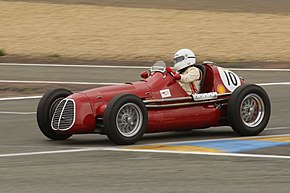Maserati A6GCM

The Maserati A6GCM was a Formula 2 racing car , built and used by Maserati .
In 1952, new regulations came into effect in Formula 1 , the highest single- seater class: the races for the drivers' world championship were driven by Formula 2 vehicles .
Maserati therefore decided to build a racing version, the A6GCM. The basis was the A6GCS , which in 1951 had shone with its versatility. The “G” in the type designation stood for the use of cast iron (“gihsa”), although the engine blocks were made of cast aluminum .
Since the engines in 1952 were allowed to have a maximum of 500 cm³ with a compressor or 2000 cm³ without a compressor, Maserati did without compressors. This waiver made the use of three Weber 38DC03 carburettors necessary. The engines got two overhead camshafts .
The chassis was taken over from the 4CL and the wheelbase was shortened to 2280 mm. The low curb weight was partly due to the body built by Fantuzzi .
Alberto Massimino and Gioacchino Colombo , both of whom came to Maserati from Scuderia Ferrari and Alfa Romeo , revised the car in 1953. Colombo did not have much time for this, however, as he left Maserati in the spring of 1955. The engine was fundamentally improved and now made 25 hp more. The rear axle has been modified and the front brakes have been reinforced. The track width was reduced to 1225 mm at the front and 1160 mm at the rear.
In terms of sport, the A6GCM was clearly inferior to its main opponent, the Ferrari 500 . For the first time, José Froilán González , who also came to Maserati from Ferrari, was able to challenge the Scuderia at the Italian Grand Prix . In the end, the Argentine only had to admit defeat to Alberto Ascari .
The big hour for Maserati and the A6GCM struck at the Italian Grand Prix a year later. The two factory Maserati of Juan Manuel Fangio and Onofre Marimón fought a race-long slipstream duel with the factory Ferrari of Ascari and Giuseppe Farina . In the last corner, the Parabolica, the last lap, Ascari turned; Fangio and Farina dodged across the grass, but Marimón could no longer dodge and crashed into Ascari. This is how Fangio celebrated Maserati's first victory in the world championship.
Maserati also sold the A6GCM to privateers. Drivers such as Prinz Bira , Gino Bianco , Felice Bonetto , Eitel Cantoni , Johnny Claes , Hermann Lang and Luigi Musso had success with the agile vehicle.
Technical specifications
| A6GCM | Year of construction 1951, 1952 and 1953; used in 1951, 1952 and 1953 |
|---|---|
| Engine: | 6-cylinder in-line engine , crankcase made of light metal |
| Bore × stroke: | 72.6 × 80 mm (1951), 75 × 75 mm (1952), 76.2 × 72 mm (1953) |
| Displacement : | 1987 cm³ (1951), 1988 cm³ (1952), 1959 cm³ (1953) |
| Compression: | 12: 1 |
| Power: | 160 PS (118 kW) at 6500 rpm (1951), 180 PS (132 kW) at 7300 rpm (1952), 197 PS (145 kW) at 8000 rpm (1953) |
| Max. Torque: | - |
| Motor control: | two overhead camshafts |
| Carburetor: | 3 × Weber 38DOC03 |
| Fuel: | Mixture of 85% methyl alcohol, 10% acetone and 5% pure benzene |
| Tank capacity: | 160 liters, from 1953 200 liters |
| Cooling: | Water, with centrifugal pump and cooler |
| Transmission: | 4-speed, 1 reverse gear, multi-plate dry clutch |
| Chassis: | Tubular steel frame |
| Front suspension: | Independent suspension, coil springs |
| Rear suspension: | Rigid axle, leaf springs |
| Shock absorber: | Houdaille lever shock absorbers front and rear |
| Brakes: | Drum brakes front and rear |
| Wheelbase: | 2280 mm, from 1953 2310 mm |
| Track: | 1278/1200 mm, from 1953 1225/1160 mm |
| External dimensions: | |
| Dry weight : | 760 kg, from 1953 570 kg |
| Top speed: | 250-280 km / h |
Literature and Sources
- Maurizio Tabucchi: Maserati, All Grand Prix, Sports and GT vehicles from 1926 until today . Heel, Königswinter 2004, ISBN 3-89880-211-6
